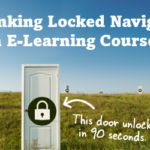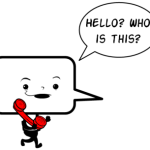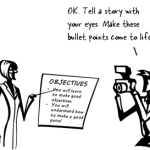I agree on two things, the challenge as is, and the challenge of changing that direction.
I to have several decades in e-learning /training business business and most of those years in corp environment. but also in innovation in the training area, VR already in 90’s etc.
Here is where i think part of the solution could be, update the marketing leading tools (articulate) to reflect the need you say is there. Rise could certainly be argued as part of the content dump problem as it is today. It needs the tracked and instructional design relevant functions yet to be added beyond quiz. If articulate were to truly take the lead on that, it would show not only understanding of customers but of the learners results. That is the end game. I dont think there is any push back to be made (guessing intention with storyline) other then to simplify the knowledge that instructional designers have and build that into tools and functions that less skilled but “available” can use. Forms based functions like scenarios in rise with added tracking and scoring. Could brake the wall of how to introduce content and measure level of understanding and weight/score the users choices as more then just right or wrong. I could even settle for none central course scoring. For scoring kept to inside the course but visible to user.
Rise has the potential but for me its not a e-learning tool just yet.
I think Articulate ( online tools) can learn from the competition such as easygenerator and the likes of those systems. Rise.com have the wrong business model. If they changed/added offering for yearly subscription with somewhat ironically unlimited secure content storage… skies the limit. But the push back should be on developer level, not on the content level. Less skilled people in the worlds training departments/people assigned to do training… is here to stay and they will eventually also be part of the skilled workforce that makes decisions. Companies like Articulate can bridge that seemingly constant gap, im guessing easily. They just needs the push to invest in their future beyond the content dump. Keep the blog going! Feel free to respond , if you do, please message me in the community.
It’s Time to Take the Content Dump to the Dump
April 26th, 2022
I’ve been at this e-learning game for close to 30 years. While the technology has changed over the years, I still see a lot of the same problems e-learning (and training for that matter) had 30 years ago.
The main problem is that pushing content passes for training. Thus a lot of what we call e-learning courses are mostly content dumps. Because the technology has made it easier to build “courses” the content looks better than it did 30 years ago; but courses like that are both ineffective training and a subpar learning experience.
This is when your instructional design skills should prevail. This is where you have an opportunity to exert some influence and craft a better learning experience.
Good E-Learning Goes Beyond E-Reading
A lot of courses (perhaps most) are content heavy with lots of text and videos. Maybe there’s some simple interactivity like a tabs interaction or one of those fancy images with labels and markers, but that’s just a different way to expose content.
There’s nothing wrong with content. Outside of e-learning, we still read text books and watch videos to learn. However, being exposed to content isn’t the same as learning which requires a few additional things: content WITH practice and feedback in some meaningful manner.
Want to move past the content dump? How are you building practice and feedback into your courses?
Good E-Learning Helps Demonstrates Understanding
Instructional design is about crafting an experience where people acquire information (content) and learn to use it (learning) in a meaningful way. In that process they are able to demonstrate their understanding of the content and how to apply it in a real-world context.
Here’s a real challenge, though.
I’ve worked in enough places where the organization didn’t really care about learning. All they wanted was a “course” with a final quiz so they can certify completion (and compliance) and say they provided training. In that environment, it’s really easy to copy and paste content into a “course” and call it good.
However, that’s not good e-learning. And it’s not effective training. It’s instructional laziness when we substitute content dumping for learning experience. And if that’s all we’re doing, there’s no need for an instructional design industry.
A course should be more than screen after screen of information. Ultimately, when a person takes a course they should be able to demonstrate a level of understanding that goes beyond simple quiz questions. It’s time to take the content dump to the dump.
As instructional designers and course builders, we should be able to push back. It helps our industry and it helps our organizations not waste time and money.
What do you think?
Events
- Everyday. Check out the weekly training webinars to learn more about Rise, Storyline, and instructional design.
Free E-Learning Resources
 |
 |
 |
|
Want to learn more? Check out these articles and free resources in the community. |
Here’s a great job board for e-learning, instructional design, and training jobs |
Participate in the weekly e-learning challenges to sharpen your skills |
 |
 |
 |
|
Get your free PowerPoint templates and free graphics & stock images. |
Lots of cool e-learning examples to check out and find inspiration. |
Getting Started? This e-learning 101 series and the free e-books will help. |
4 responses to “It’s Time to Take the Content Dump to the Dump”
Sometimes it feels like our organizations understand that they are not doing a great job with remote instruction, but ultimately they perceive that it is too hard to develop asynchronous training that gives measurable results.
COVID has engendered a huge pushback against remote learning because of how rapidly people had to pivot in 2020. Most organizations were not prepared to switch and did not make a smooth transition. Now everyone in the US is sick of everything being online, and asynchronous e-learning is often used as a convenient example of how society is failing K-12 students and adult learners.
To directly address the “content dump” analogy, I firmly believe that all online communications correlate to a purpose. Every email, blog post, social media item, online course, shared video, etc. can potentially be training if its purpose is clear. Every online interaction that an organization engages in should be developed with some measurable change in mind.
E-learning courses are best used as one tool among a suite of interactions used over time to achieve organizational goals. Interactive products created by rapid development tools like Storyline are the next best thing to having an instructor to check knowledge retention and provide learners with validation.
Expanding on what Tom says above, unless there is some sort of practice and feedback, our online content is likely to be forgotten soon after it is posted.
What a wonderful feeling to read your post and understand completely what you mean! I could relate to every word.
To prevent a total content dump, I insist upon creating 3-4 learning objectives, knowledge checks throughout that test those objectives, and a summary that reinforces those objectives.









0
comments